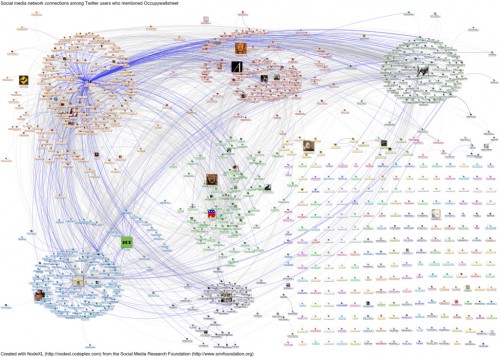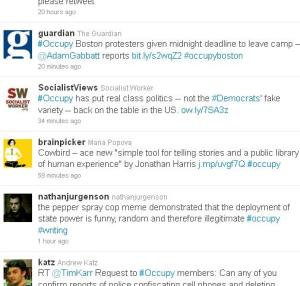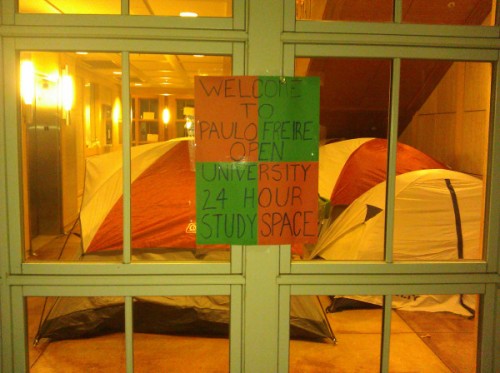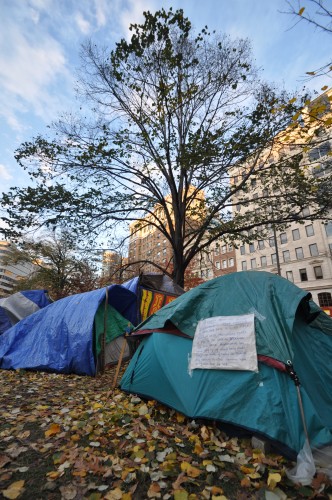
This is a disorganized photo essay with my photos and random ruminations from Occupy Congress last week.
Larger versions of these photos; am very happy to share them, just ask and/or credit me: twitter.com/nathanjurgenson

This is a disorganized photo essay with my photos and random ruminations from Occupy Congress last week.
Larger versions of these photos; am very happy to share them, just ask and/or credit me: twitter.com/nathanjurgenson

Kurt Anderson’s recent article in Vanity Fair titled “You Say You Want a Devolution.” contends that the past 20 years have seen a total stagnation in the production of new cultural aesthetics. In other words, the end of the 50s looked nothing like the end of the 70s, but 1989 looks remarkably similar to 2009. Anderson concludes:
We seem to have trapped ourselves in a vicious cycle-economic progress and innovation stagnated, except in information technology; which leads us to embrace the past and turn the present into a pleasantly eclectic for-profit museum; which deprives the cultures of innovation of the fuel they need to conjure genuinely new ideas and forms; which deters radical change, reinforcing the economic (and political) stagnation.
This is concerning, since that means the entirety of our blog is nothing more than the fungal growth sitting upon the neutral technological substrate that we impregnate with decaying cultures of past decades. Tattoos, Facebook, Burning Man, the iPhone, Twitter, sex dolls, wifi, internet memes, reality TV, geek culture, hipsters, video games, faux-vintage photographs, and dubstep are all popular topics on our blog, and (along with blogging itself) are products of the last 20 years. Anderson assumes that cultural objects are made possible through technology, but refuses to admit that technologies can also be cultural objects in and of themselves. more...

Americans have gotten so good at being consumers that it almost seems hackneyed to acknowledge such a thing. I say “almost” because there are still wonderfully interesting things being said in some literary and academic circles that continually find deeper levels of meaning in the seemingly shallow end of the societal pool. Our near-perfect systems of consumption not only make it technically possible to exchange beautifully designed plastic gift cards,but it makes it socially acceptable as well. A gift-giver can reliably assume that the recipient a thousand miles away has access to the same stores, with almost the exact same products. The gift-giver can also assume a certain level of homogeneity about gift-giving practices. Most of us share a set of common beliefs about what constitutes a good gift: It should, relate to our interests, be useful, carry sentimental value, reflect the nature of a relationship, provide entertainment, and/or fill a need. When you give a gift card, you are acknowledging the need or want, but allowing the receiver to specify its final material (or digital) form. This system relies on stability and uniformity to function smoothly. There must be a common culture, as well as a reliable stream of goods and services. But such stability is becoming less, and less likely. Whether it is peak energy, financial collapse, or a little bit of both- our world is becoming less predictable and the systems that rely on steady streams of capital and petroleum are breaking down. In their place, we might begin to find self-organizing systems that are not only more efficient, but also much more just forms of resource distribution. more...
There is a good conversation to have on just how leaderless the Occupy movement is. It is more networked and decentralized, but, of course, not perfectly so. Structures and hierarchies always emerge. Unfortunately, this important conversation is derailed when some try to create fictional leaders for a movement that, for the most part, does not have them. Articles like, for instance, John Heilemann’s New York Magazine expose on Occupy, again and again force leader-language on the movement. And they do so unsuccessfully.
The traditional media wants to tell a traditional story, and this is why they get Occupy so terribly wrong. It is easier to describe a movement of leaders, of charismatic personalities and of specific ideas, messages and demands. The media momentum favors retelling the type of story they have told before.
But the reality for Occupy is much more complicated. Yes, the movement is not completely leaderless. Participation and efficaciousness are not evenly distributed across the 99%. For instance, the term “occupy” was not arrived to by some consensus but instead the creation of Adbusters. However, the magazine has claimed that they “have no interest in a continuing leadership role.” Instead, the magazine’s role has been aesthetic: to come up with good memes.
While pure leaderlessness may not be possible or even wanted for Occupy, the bigger story is that it is more decentralized than previous political movements. The high degree more...

Two days ago, Nathan Jurgenson wrote on what has become one of the central questions around Occupy Wall Street: Now that the encampments are closing up and the winter is coming on, can Occupy survive? The crucial point that Nathan makes is that we need to think about Occupy not just in terms of space but in terms of time – that permanence has been a part of what’s given the movement so much symbolic and discursive power. Nathan brings up an additional point, to which I want to respond here: that the role of physical permanence that the encampments represented was powerful because it resulted in a form of cognitive permanence in the minds of everyone who saw them (and heard them; the auditory side of Occupy is also vital to pay close attention to).
While I clearly agree with Nathan that the physical permanence that tents represent has been what’s given Occupy a lot of its power, I think we can glean enough evidence from how things have proceeded so far to at least make an educated guess at an answer to his question. For me, the answer is yes: I expect that Occupy will survive the winter and emerge in spring, albeit – like a bear emerging from hibernation – perhaps in somewhat of a different shape. There are several reasons why I come down on this side of things.

At exactly the moment when tents are disappearing, when, at least for the winter, Occupy is trading long-term omnipresence for short-term actions, Occupy DC made news for building a large, wooden, winterized structure in a city park. The Occupy DC barn fiasco can be understood, in part, as a move to double-down on the endurance of the Occupy movement precisely when it is at risk of losing that secret ingredient that made it powerful: time.
As Sarah Wenechak wrote, tents pitched in city parks come to be more than practical but also symbolic. And part of this value is that they represent time. Overall, much of the writing about Occupy has focused on space. Traditional protest actions, like marches, claim physical space but merely do so for short periods of time (especially as the march moves from location to location occupying any particular space for a only very brief amount of time). While that big umbrella term “occupy” certainly refers to space, there has also been a special focus on time.
A tent, for example, proclaims that more...

Cyborgology editors Nathan Jurgenson and PJ Rey on WYPR (Baltimore’s NPR affiliate) discussing technology and the Occupy movement: Click here to listen to the audio.
 When the occupiers in Zuccotti Park began setting up tents, it was an inherently practical move. After cold, uncomfortable nights on tarps and huddled into sleeping bags (a situation imposed by a no-tent policy in the park, which was eventually not enforced), tents were a welcome way to make an occupied space more of a home, and closer to familiar conceptions of an established community.
When the occupiers in Zuccotti Park began setting up tents, it was an inherently practical move. After cold, uncomfortable nights on tarps and huddled into sleeping bags (a situation imposed by a no-tent policy in the park, which was eventually not enforced), tents were a welcome way to make an occupied space more of a home, and closer to familiar conceptions of an established community.
But we need to understand tents as more than just tents.

After the many, many evictions which have taken place over the last several weeks, both here in Canada and in the United States, there has been a lot of discussion about the ‘next phase’ of the Occupy movement. My personal interest has been focused, from the start, on the specific instance of the New York occupation, so it is their eviction and current situation which interests me the most. I specify this up front because I think it is difficult to speak about the OWS movement as a Whole in meaningful terms, since each occupation is so localized. I like the comparison to open-source projects for this: some useful generalizations are possible, but the source code is open to tinkering and adapted to each specific use.
Recently, the NY Occupation was evicted from their previous home at Liberty park, and scattered to the four winds. They have so far proven that they have the institutional robustness to deal with this by continuing to provide food and shelter to all in need, as well as continuing to effectively plan and implement direct actions along with effective media. They have even continued their regularly scheduled General Assemblies and Spokes Councils, despite cold weather, a hard time finding space, and what seem to be increasing feelings of tension amongst certain committed members.
I see this continued ability to act as centrally linked to their being an Augmented Movement. Because they represent this blend of atoms and bits they have been able to continue coordinating effectively by transferring ever more of that coordination online. However, as an augmented movement, they face unique problems. Bits are well and good, but atoms are tricky things, and certain things can only continue to happen offline: people need food and places to stay, as well as the need to meet and communicate face to face so that strong links can be maintained along with the horizontal institutions upon which the current movement is premised. It is this second aspect of their problem which I find most interesting, and challenging. more...